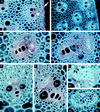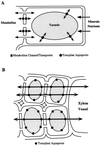High expression of the tonoplast aquaporin ZmTIP1 in epidermal and conducting tissues of maize
- PMID: 9701571
- PMCID: PMC34879
- DOI: 10.1104/pp.117.4.1153
High expression of the tonoplast aquaporin ZmTIP1 in epidermal and conducting tissues of maize
Abstract
Aquaporins are integral membrane proteins of the tonoplast and the plasma membrane that facilitate the passage of water through these membranes. Because of their potentially important role in regulating water flow in plants, studies documenting aquaporin gene expression in specialized tissues involved in water and solute transport are important. We used in situ hybridization to examine the expression pattern of the tonoplast aquaporin ZmTIP1 in different organs of maize (Zea mays L.). This tonoplast water channel is highly expressed in the root epidermis, the root endodermis, the small parenchyma cells surrounding mature xylem vessels in the root and the stem, phloem companion cells and a ring of cells around the phloem strand in the stem and the leaf sheath, and the basal endosperm transfer cells in developing kernels. We postulate that the high level of expression of ZmTIP1 in these tissues facilitates rapid flow of water through the tonoplast to permit osmotic equilibration between the cytosol and the vacuolar content, and to permit rapid transcellular water flow through living cells when required.
Figures





References
-
- Barrieu F, Thomas D, Marty-Mazars D, Charbonnier M, Marty F. Tonoplast intrinsic proteins from cauliflower (Brassica oleracea L. var. botrytis): immunological analysis, cDNA cloning and evidence for expression in meristematic tissues. Planta. 1998;204:335–344. - PubMed
-
- Canny MJ. Vessel contents during transpiration: embolisms and refilling. Am J Bot. 1997;84:1223–1230. - PubMed
LinkOut - more resources
Full Text Sources
Other Literature Sources

